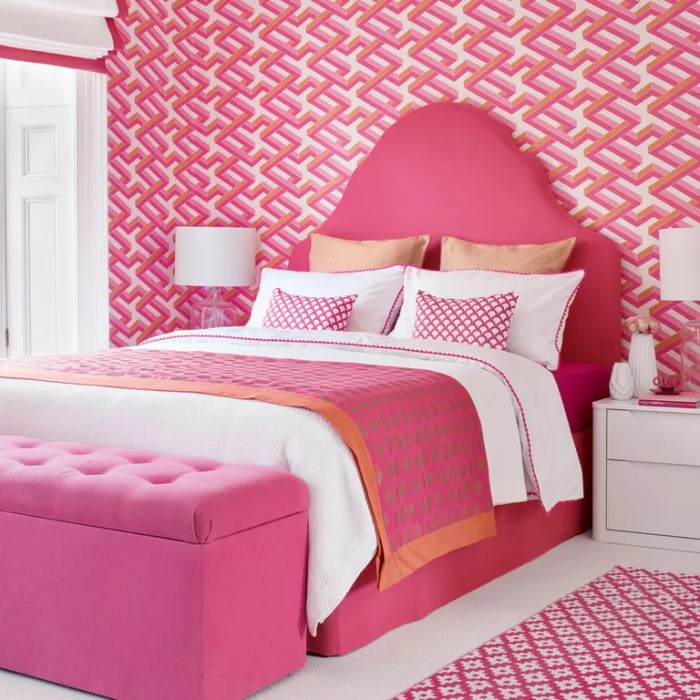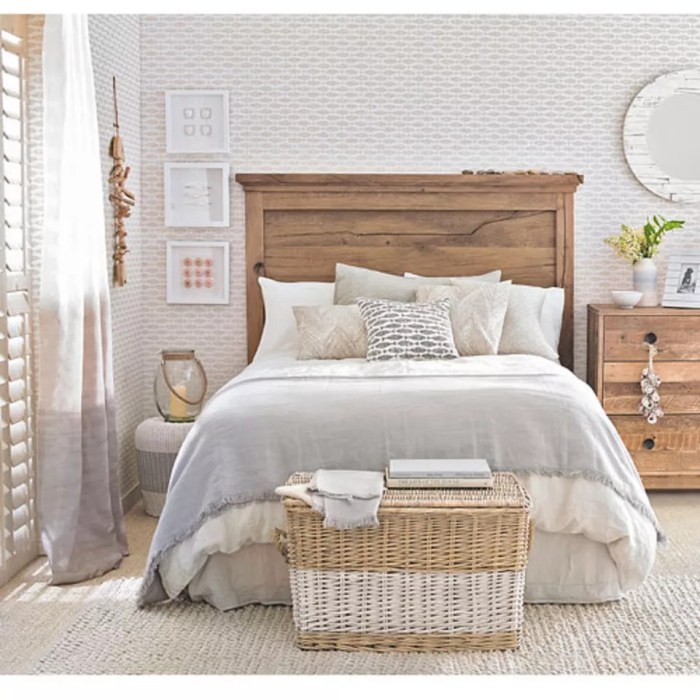Interior Design Master Bedroom A Comprehensive Guide
Space Planning and Functionality: Interior Design Master Bedroom

Interior design master bedroom – Effective space planning and thoughtful furniture placement are crucial for creating a relaxing and functional master bedroom suite. A well-designed layout ensures ease of movement, maximizes storage, and enhances the overall aesthetic appeal of the space. Consideration of traffic flow, furniture arrangement, and the integration of essential elements like a walk-in closet and ensuite bathroom are paramount.
A successful master bedroom design prioritizes both aesthetics and practicality. The following sections delve into specific aspects of space planning, focusing on furniture arrangement, storage solutions, and the impact of ceiling height.
Master Bedroom Suite Floor Plan
The following floor plan illustrates a functional master bedroom suite incorporating a walk-in closet and ensuite bathroom. The design emphasizes efficient traffic flow and maximizes space utilization. Careful consideration of furniture placement ensures ample space for movement and comfortable use of each area.
Furniture included:
- King-size bed positioned against the wall opposite the entrance for a focal point.
- Two nightstands flanking the bed, providing convenient bedside storage.
- A dresser positioned along a wall, providing ample storage for clothing and accessories.
- A comfortable seating area with an armchair and a small side table, creating a relaxing space for reading or relaxing.
- A walk-in closet with ample shelving, drawers, and hanging space for clothing and shoes.
- An ensuite bathroom with a double vanity, shower, and toilet.
Maximizing Storage in the Master Bedroom
Maximizing storage is paramount in a master bedroom to maintain a sense of order and tranquility. Clutter can significantly impact the overall feeling of the room, making it feel smaller and less relaxing. Therefore, strategic storage solutions are essential.
Master bedroom interior design hinges on creating a relaxing sanctuary. A key element often overlooked is the door itself; selecting the right one significantly impacts the overall aesthetic. For truly stylish results, consider exploring options like those showcased in this guide on stylish modern bedroom door design , which offers a wealth of inspiration for completing your master bedroom’s sophisticated look.
The right door can elevate the entire space, tying together your chosen color palette and furniture style.
Creative storage solutions:
- Built-in wardrobes: Custom-designed wardrobes seamlessly integrate into the room’s architecture, maximizing vertical space and providing ample storage. They can be tailored to specific needs, including shelving, drawers, and hanging space for clothes, shoes, and accessories.
- Under-bed storage: Utilizing the space under the bed with drawers or lift-up mechanisms provides hidden storage for seasonal items, linens, or extra blankets.
- Floating shelves: These offer a stylish and space-saving way to display books, decorative items, or personal belongings, keeping surfaces clear and organized.
- Ottoman storage: An ottoman with built-in storage can serve as extra seating and provide a discreet place to store blankets, pillows, or other items.
Impact of Ceiling Height on Master Bedroom Design, Interior design master bedroom
Ceiling height significantly influences the overall feel of a master bedroom. High ceilings create a sense of grandeur and spaciousness, while low ceilings can feel more intimate and cozy. Understanding this impact allows for strategic design choices to enhance the room’s ambiance.
Working with different ceiling heights:
- High ceilings: In rooms with high ceilings, tall furniture can help to balance the proportions and prevent the room from feeling cavernous. Consider a statement chandelier or tall bookshelves to draw the eye upward and add visual interest.
- Low ceilings: Light colors, minimal furniture, and vertical lines can help to create an illusion of more height in rooms with low ceilings. Avoid bulky furniture and opt for streamlined designs to maintain a sense of spaciousness. Mirrors placed strategically can also help to reflect light and visually expand the space.
Master Bedroom Accessories and Decor

Creating a truly luxurious and personalized master bedroom involves careful consideration of accessories and decor. These elements add character, functionality, and a touch of personal style, transforming a simple space into a haven of comfort and sophistication. The right choices can significantly impact the overall ambiance, reflecting the homeowner’s taste and creating a space that feels both inviting and uniquely their own.
Statement Pieces for an Elevated Master Bedroom
Five carefully selected statement pieces can dramatically elevate the design of a master bedroom. These pieces act as focal points, drawing the eye and setting the overall tone. Consider these options for maximum impact:
- A dramatic canopy bed: A large, ornate canopy bed instantly creates a sense of grandeur and opulence. The canopy itself can be made from a variety of materials, from luxurious velvet to sheer silk, influencing the overall mood. The bed frame’s material, whether wrought iron, polished wood, or upholstered, will also play a significant role in the aesthetic. For example, a dark wood canopy bed with rich velvet drapes would lend a traditional, romantic feel, while a sleek, minimalist canopy bed in a light-colored wood would offer a more modern aesthetic.
- An oversized statement mirror: A large, ornately framed mirror not only adds functionality but also expands the perceived space and reflects light, brightening the room. The frame itself can be a significant design element. A gilded baroque mirror would add a touch of antique elegance, while a minimalist mirror with a sleek, modern frame would complement contemporary decor. A full-length mirror placed strategically can also improve the functionality of the room.
- An eye-catching area rug: A large area rug anchors the space and adds warmth and texture. The choice of rug material, pattern, and color significantly impacts the overall feel. A plush, shag rug in a rich jewel tone would create a luxurious and cozy atmosphere, while a geometric patterned rug in neutral tones would provide a more modern and sophisticated look.
Consider the size of the rug in relation to the room to avoid making the space feel cramped.
- A unique piece of artwork: A large-scale painting or sculpture can serve as a stunning focal point, adding personality and visual interest. The style of artwork should complement the overall design scheme. A bold abstract painting could add a contemporary touch, while a classic landscape painting could create a more traditional feel. Consider the artwork’s color palette and how it interacts with the existing color scheme.
- An antique or vintage chest: A beautifully crafted antique or vintage chest provides both storage and visual appeal. The chest’s material, design, and patina contribute significantly to the room’s aesthetic. A weathered wooden chest adds rustic charm, while a lacquered chest with intricate detailing offers a more refined and elegant look. The chest can serve as a nightstand or a decorative element at the foot of the bed.
Essential Accessories for a Functional and Stylish Master Bedroom
The following accessories are crucial for creating a functional and stylish master bedroom, enhancing both practicality and aesthetic appeal. These items work together to create a cohesive and comfortable space.
- Nightstands: Essential for bedside storage and convenience. Choose nightstands that complement the bed and overall style, offering adequate surface area and storage space.
- Lighting: A combination of ambient, task, and accent lighting is crucial for creating a versatile and functional space. Consider bedside lamps, overhead lighting, and perhaps even a dimmer switch for ambiance.
- Curtains or blinds: Provide privacy and light control. Choose fabrics and styles that complement the overall decor, considering light filtering and insulation properties.
- Bedding: High-quality bedding is essential for comfort and visual appeal. Consider the fabric, color, and pattern to create a cohesive and stylish look.
- Throw pillows and blankets: Add texture, color, and comfort. Experiment with different fabrics, patterns, and textures to create visual interest.
- Mirrors: Strategically placed mirrors can make the room feel larger and brighter. Consider a full-length mirror or smaller decorative mirrors.
- Storage solutions: Ample storage is crucial for maintaining organization. Consider chests, dressers, ottomans with storage, and closet organizers.
- Rugs: Add warmth, comfort, and visual interest. Choose a rug that complements the overall style and color scheme.
- Plants: Add life and freshness to the space. Choose plants that thrive in the bedroom environment and complement the decor.
- Artwork and decorative objects: Personalize the space and add visual interest. Choose pieces that reflect your style and create a cohesive look.
Artwork and Decorative Elements in a Master Bedroom Design
Imagine a master bedroom featuring a large, abstract painting in calming blues and greens, hung above the bed. The painting, with its fluid brushstrokes and subtle texture, creates a sense of serenity and tranquility. Its muted color palette complements the soft grey walls and white bedding, while the organic forms in the artwork add a touch of nature to the space.
To balance the large painting, two smaller framed botanical prints are placed on the nightstands, echoing the painting’s calming color scheme and natural theme. A simple, yet elegant, patterned rug in shades of grey and blue anchors the space, tying the entire color palette together. A few carefully chosen decorative objects – a ceramic vase with dried flowers, a small sculpture on a shelf – add subtle visual interest without overwhelming the space, reinforcing the feeling of calm and sophistication.
The overall effect is a sophisticated, yet inviting and restful atmosphere.
FAQ Summary
What is the best bed size for a master bedroom?
The ideal bed size depends on the room’s dimensions and personal preference. A king-size bed is common for spacious rooms, while a queen-size is suitable for smaller spaces. Consider the available floor space and your comfort level.
How much should I budget for master bedroom renovation?
Master bedroom renovation costs vary significantly based on the scope of work, materials chosen, and location. Research local contractors and obtain multiple estimates to understand the potential expense.
How can I make my master bedroom feel more luxurious?
Incorporate high-quality linens, plush rugs, and statement lighting fixtures. Consider adding a comfortable seating area and incorporating elements like a fireplace or a spa-like ensuite bathroom to enhance the sense of luxury.















